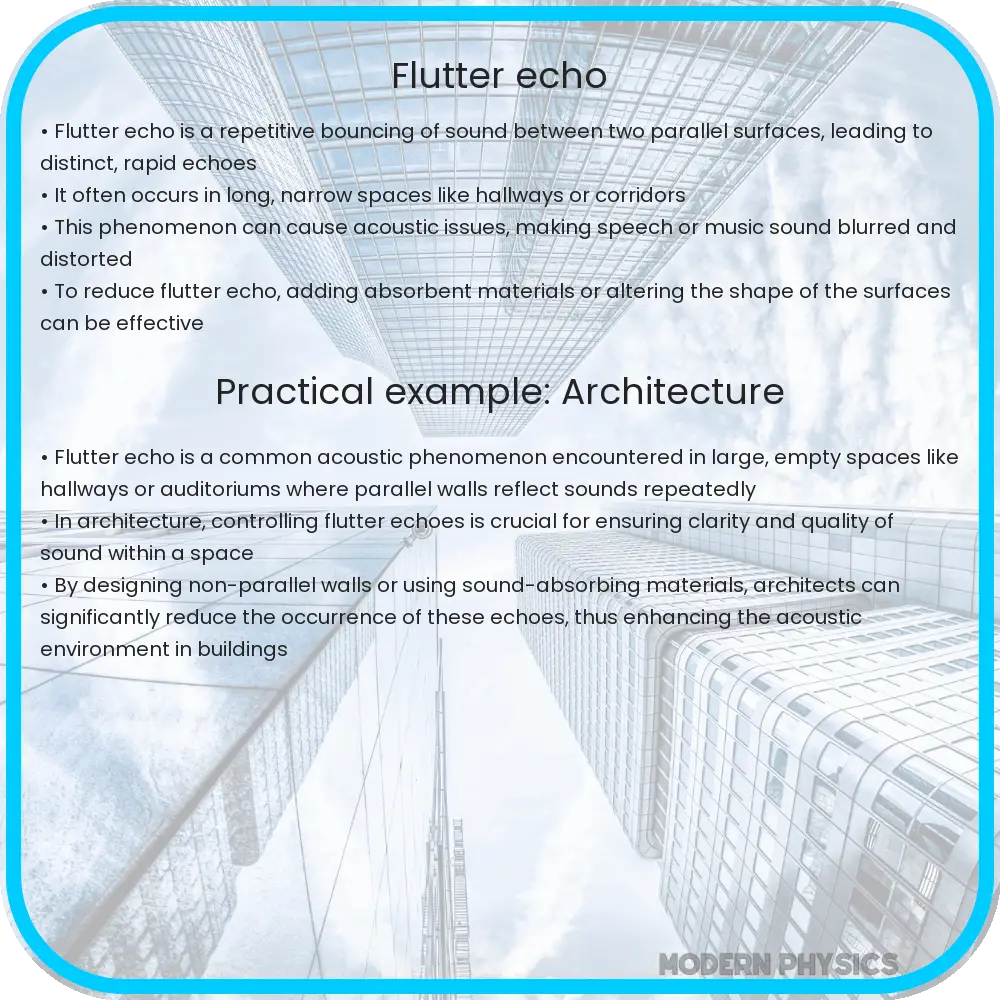Learn about flutter echo, an acoustic issue caused by sound bouncing between parallel surfaces, affecting speech clarity and music quality in enclosed spaces.

Understanding Flutter Echo in Room Acoustics
Flutter echo is a common acoustic phenomenon experienced in rooms and enclosed spaces. It occurs when sound repeatedly bounces back and forth between two parallel surfaces, such as walls. This repetitive reflection can create a series of rapidly repeating sounds that decay gradually, often described as a ‘ripping’ or ‘flapping’ sound. Understanding flutter echo is crucial for achieving clear acoustics and enhancing sound quality in any environment.
Causes and Impact of Flutter Echo
The primary cause of flutter echo is the reflection of sound waves between any two hard, parallel surfaces. This can include the walls of a room, the floor and ceiling, or between large objects within a space. When sound waves reflect without much absorption, they can create standing waves that reinforce certain frequencies and diminish others. The result is often a distorted sound that can interfere with clarity and reduce the overall quality of the acoustic environment.
Flutter echo not only affects the clarity of speech but can also distort music, making it difficult to appreciate the nuances of different instruments or performances. In settings such as auditoriums, theaters, and recording studios, controlling flutter echo is essential for delivering a high-quality auditory experience.
Strategies for Controlling Flutter Echo
To effectively manage flutter echo, several strategies can be employed:
- Surface Angulation: By avoiding parallelism between surfaces, the direct pathway for flutter echoes can be eliminated. Angled or non-parallel walls help in dispersing sound waves rather than allowing them to bounce back and forth.
- Sound Absorption Materials: Installing materials that absorb sound can dramatically reduce reflections. Common materials include acoustic panels, foam, heavy curtains, and carpeting. These materials absorb sound energy rather than reflecting it, diminishing the intensity of flutter echoes.
- Diffusion: Sound diffusers scatter the sound waves, spreading them out in various directions rather than allowing them to bounce directly between surfaces. Diffusers come in many forms, such as quadratic residue diffusers or skyline diffusers, and are effective in controlling echo and reverberation.
By integrating these strategies into architectural design and room treatment, it’s possible to significantly improve sound quality, eliminating disturbances like flutter echo. This enhances the auditory experience, whether for casual listening, professional communication, or performance.
Detecting Flutter Echo
Detecting flutter echo is the first step toward mitigation. A simple method involves producing a sharp sound, such as a clap, in the space in question and listening for the characteristic flapping or rapid repetition decay of the echo. Professionals might use specific acoustic measurement tools and software to analyze the sound and identify problematic reflections.
Once detected, the specific characteristics of the flutter echo, such as its frequency and decay time, can be analyzed to determine the best course of treatment. Using a combination of absorption, diffusion, and strategic surface design, it is possible to achieve a balanced acoustic environment that is free from unwanted echo effects.
Real-World Examples of Flutter Echo Control
In real-world scenarios, controlling flutter echo can dramatically enhance the acoustic quality of a space. For instance, in modern auditoriums, designers often incorporate non-parallel wall structures and strategically placed sound-absorptive materials. These modifications ensure that sound is evenly distributed throughout the space, minimizing echoes and enhancing speech intelligibility.
In recording studios, the control of flutter echo is crucial to capturing clean audio devoid of acoustical artifacts. Professionals use a combination of dense absorptive panels and diffusers to mould the sound environment, achieving the ideal balance between direct sound and ambient quality.
Conclusion
Flutter echo is a pervasive issue in many enclosed spaces, but understanding and controlling it can significantly improve sound quality. The phenomenon arises from sound waves bouncing between parallel hard surfaces, leading to repeated echoes that can muddle auditory clarity and degrade overall acoustic quality. Through strategic room design—avoiding parallel surfaces, using sound-absorptive materials, and applying diffusers—it’s possible to minimize the impact of flutter echoes.
Effective management of flutter echo enhances everything from daily communication in offices and public spaces to performances in large venues and recordings in studios. By employing simple detection methods and combining various treatment strategies, one can create an acoustically pleasing environment conducive to clear sound transmission. Thus, a well-considered approach to handling flutter echo not only solves a common acoustic problem but also enriches the listening experience for everyone in the space.
